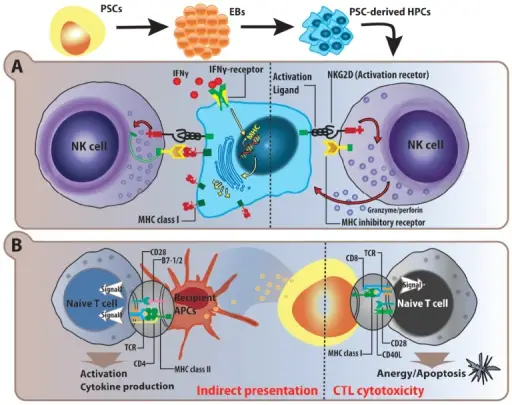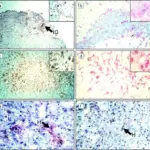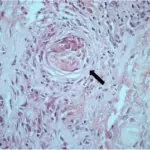
Simplified schematic of natural killer and T cell immune responses towards PSCs and their progeny. A) PSCs and PSC-derived hematopoietic progenitor/stem cells (HPC) express low levels of MHC class I molecules, which make them susceptible to NK cell recognition and cytotoxicity. Even though PSC-derived HPCs have a low expression of NK activation ligands, the lack of MHC molecules for inhibitory signal alone will trigger NK cell killing by the release of granzyme and perforin. In vitro IFNγ stimulation augments MHC expression on PSC-derived HPCs, and is in turn, protective against NK cell cytotoxicity via binding of MHC class I on the NK inhibitory receptor. B) Due to the lack of co-stimulatory signals in the activation process, CD8+ cytotoxic T lymphocytes (CTLs) specific to PSC antigens are anergized, and subsequently results in apoptotic cell death. As in the indirect allogeneic recognition, recipient professional antigen presenting cells (APCs) can pick up PSC-derived embryonic antigens, and present to specific CD4+ T helper cells. With complete signal 1 from TCRs and signal 2 from co-stimulatory molecules, indirect recognition against PSCs will trigger immune rejection responses. Immunogenicity and tumorigenicity of pluripotent stem cells and their derivatives: genetic and epigenetic perspectives.
Tan Y, Ooi S, Wang L - Current stem cell research & therapy (2014).Not Altered. CC.
The immune system of the host identifies its own cells and differentiated them from the foreign antigens present on the cellular surface of the transplant. There are two pathways of allorecognition: Direct allorecognition and indirect allorecognition.
The direct pathway of allorecognition involves intact allo-MHC molecules expressed on the transplant cells that are recognized by T cells. The direct allo-recogntion response is rapid and results in acute cellular rejection.
The indirect pathway of allorecogntion, involves allo-MHC molecules that are not intact that are shed from the donor cell surface. These are taken up by antigen-presenting cells (APC) and are presented to T cells. The activated T cells take up further signaling by secreting the cytokines. The indirect allorecognition is slower and results in chronic rejection.



